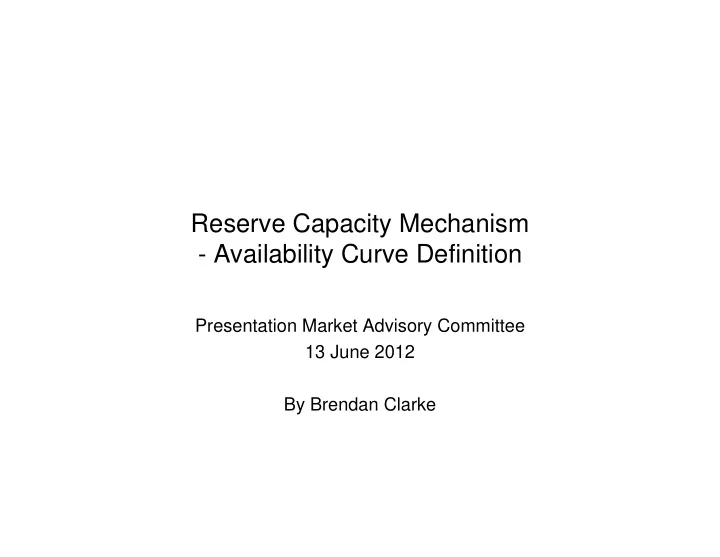

Reserve Capacity Mechanism - Availability Curve Definition Presentation Market Advisory Committee 13 June 2012 By Brendan Clarke
Issue Statement “ There is a lack of clarity in the formation of the Availability There is a lack of clarity in the formation of the Availability Curve. This has the potential to threaten system reliability ”.
Definition Issue Market Rule 4.5.10(e) defines the Availability Curve. “a two dimensional curve for each of the 2nd and 3rd Capacity Years of the Long Term PASA Study Horizon describing the information referred to in clause 4.5.12”
Formulation Issue There is no guidance in the rules or procedures as to how to formulate the “Availability Curve” The curve that forecasts the availability requirements of “Availability Curve”. The curve that forecasts the availability requirements of generation and demand side programs for the upcoming capacity year. The rules indicate that a graph should be produced covering a capacity year (12 months) , this gives the horizontal dimension, and the remainder is not defined. Market Rule 4.10.5(b) indicates that it should include the “Reserve Capacity Target” (RCT) only, this gives the vertical dimension and quantum. Possible curves can be postulated that meet this criteria
time Possible Availability Curve #1 (Chronological format) 1/10/x+1 1/10/x RCT x MW
Possible Availability Curves (LDC Format) MW RCT x Capacity Available to Limited Availability Classes Percentage of time exceeded
Reliability Issue The Availability Curve formulation is crucial for reliability and defines the capacity that is available to the various capacity classes. Its lack of definition is not transparent and can lead to less than adequate system reliability Proposed Solution System Management believes that this can be addressed by proposing a rule change which defines explicitly how the “Availability Curve” is defined and to be formulated. f “ C f f It is proposed that this will be achieved by defining each component of the availability c r e based on the planning criterion gi en in Market r le 4 5 9 being curve based on the planning criterion given in Market rule 4.5.9 being Reserve Capacity Target = Th The Forecast Demand Shape F t D d Sh + The Reserve Margin and its availability requirement + The Frequency Keeping Capacity and its availability requirement (These components are shown graphically overleaf)
Formulation of the Availability Curve (Chronological Format) MW RCT x Load Curve Reserve Margin Minimum Frequency Keeping Capacity 1/10/x 1/10/x+1
Formulation of the Availability Curve (LDC Format) MW RCT x Load Duration Curve Reserve Margin Minimum Frequency Keeping Capacity Percentage of time exceeded
Reasons for Availability Durations Reasons for Availability Durations The availability curve defines what resources are required to ensure reliable operation of the SWIS. The load curve must be met and so resources must be available for the same duration as the forecast load. This uses benchmark load profiles plus an allowance for 1 in 10 year events and an allowance for intermittent loads f i t itt t l d The Minimum Frequency Keeping Capacity, e.g extra capacity to meet load and non scheduled variations, must be available at all times as variations in load and non-scheduled generation can occur at peak i ti i l d d h d l d ti t k load times (day time) and off peak times (night time), hence resources must be available 24/7 The Reserve Margin, e.g extra capacity to meet the Forced Outages of Th R M i t it t t th F d O t f scheduled generators, Fuel Restrictions and Network Restrictions. This must be available at all times as reduction in the delivery of scheduled generation can occur at peak load times (day time) and off peak times (night time) hence resources must be available 24/7 off peak times (night time), hence resources must be available 24/7
What this does What this does • Ensures the correct mix of facilities with different availability classes are selected to meet the planning criteria
Possible Availability Curves (LDC Format) Possible Capacity Available to Limited Availability MW Classes Classes RCT x Percentage of time exceeded
What this does not • Change the Reserve Capacity Target or change the cost of capacity credits to the market • Limit the amount of capacity procured by the various availability classes
Draft Wording of 4.5.10(e). Draft Wording of 4 5 10(e) “develop a two dimensional curve for each of the 2nd and 3rd Capacity Years of the Long Term PASA Study Horizon describing the information referred to in clause 4.5.12 (“Availability Curve”). This i f ti f d t i l 4 5 12 (“A il bilit C ”) Thi curve shall be the minimum capacity that must be made available from facilities holding capacity credits for each trading interval in the capacity year and calculated as the sum of: The forecast demand for each trading interval of the Capacity Year with a peak demand equal to the forecast peak demand given in 4.5.9(a), and The Reserve Margin equal to the reserve margin given in 4.5.9(a) and is required to be available at this value for the entire Capacity Year, and The Minimum Frequency Keeping Capacity given in 4.5.9(a) and is required to be available at this value for the entire Capacity Year.”
Recommend
More recommend